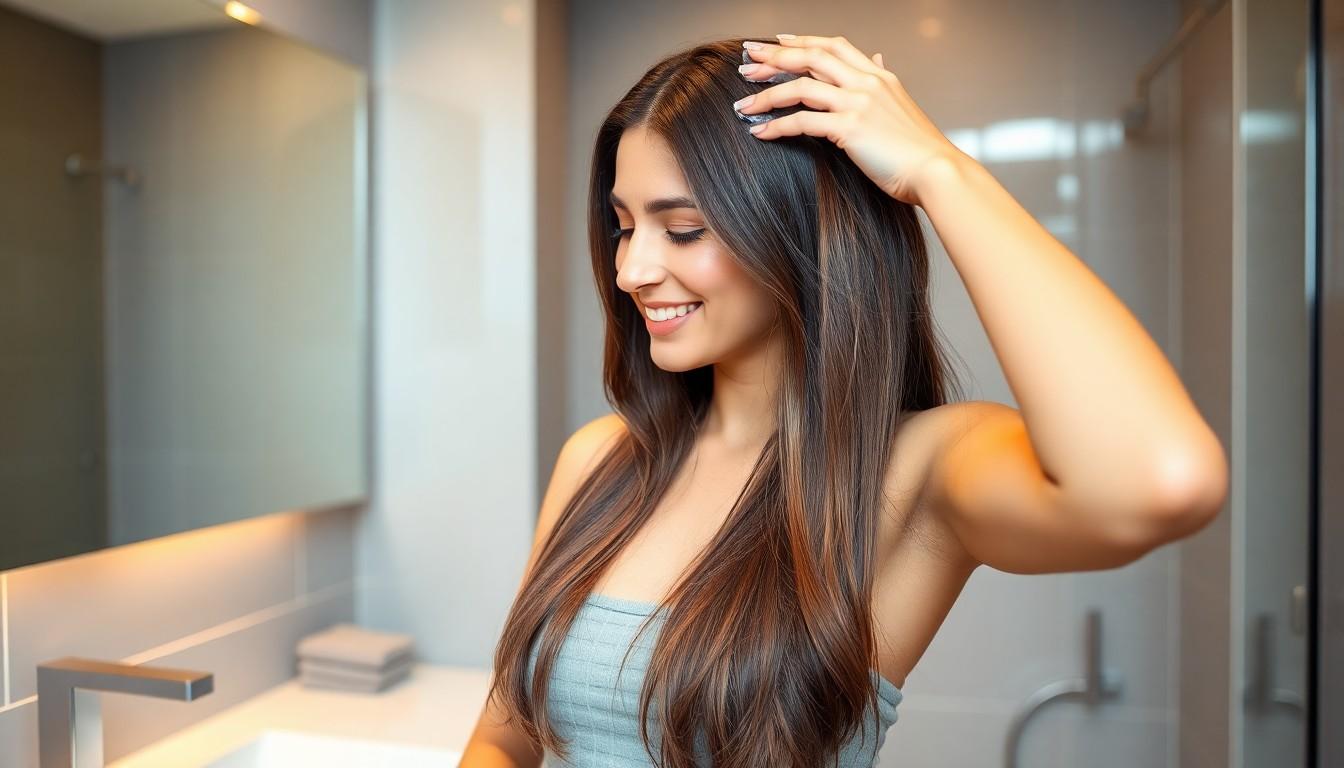Wondering how often you should wash your hair? You’re not alone. With contradicting advice everywhere, finding the right hair-washing frequency can feel overwhelming. We’ll cut through the confusion and help you discover your ideal routine.
The truth is, there’s no one-size-fits-all answer. Your perfect wash schedule depends on several factors: hair type, scalp condition, lifestyle, and even the season. What works for someone with oily hair won’t necessarily work for those with dry, curly, or color-treated locks. We’ve consulted top dermatologists and hair experts to bring you science-backed recommendations customized to your exact needs.
Understanding Your Hair Type: The Foundation of Washing Frequency
Your hair type plays a crucial role in determining how often you should wash your hair. Different hair textures and scalp conditions have unique needs that directly impact optimal washing frequency. Let’s explore how various hair types influence your wash schedule.
Fine vs. Thick Hair
Fine hair typically requires more frequent washing than thick hair. People with fine hair often notice their strands get oily faster because there’s less hair to absorb the scalp’s natural oils. We recommend washing fine hair every 1-2 days to prevent it from looking flat and greasy. Thick hair, conversely, can usually go 2-4 days between washes because the abundance of strands takes longer to show oil buildup. Many thick-haired individuals find that washing too frequently strips their hair of necessary moisture, leading to dryness and potential damage. Volume and density affect how quickly sebum travels down the hair shaft, making these factors essential considerations when establishing your washing routine.
Straight vs. Curly Hair
Straight hair generally needs more frequent washing than curly hair. Oil travels down straight hair shafts more easily, making strands appear greasy faster—typically within 1-2 days after washing. Curlier hair types can often extend their wash schedule to 3-7 days because natural oils have difficulty handling the curved hair shaft. Most curly-haired people actually benefit from less frequent washing, as their hair texture tends to be drier and needs those natural oils for moisture and definition. Co-washing (using conditioner instead of shampoo) has become popular among those with curly hair, allowing them to refresh their curls without stripping essential oils. Texture significantly impacts how sebum distributes throughout your hair, making it a key factor in determining washing frequency.
Oily vs. Dry Scalp
Scalp condition drastically affects how often you should wash your hair. Those with oily scalps typically need to wash their hair more frequently—sometimes daily—to remove excess sebum that can make hair look greasy and flat. Dry scalp conditions usually benefit from less frequent washing, with 2-3 times per week being sufficient for most people. Washing too often can strip already dry scalps of necessary oils, potentially worsening issues like flaking and irritation. Many dermatologists recommend sulfate-free shampoos for those with dry scalps to maintain natural moisture balance without causing further dryness. Sebum production varies significantly between individuals based on genetics, hormones, and environmental factors, making personalized assessment necessary for determining optimal wash frequency.
How Often to Wash Different Hair Types

Different hair types require different washing frequencies to maintain optimal health and appearance. Understanding your exact hair type can help you develop the best washing schedule.
Daily Washing: Who Needs It
Daily washing works best for individuals with naturally oily hair or those who use styling products every day. People with oily scalps benefit from daily cleansing to manage excessive sebum production that can make hair look greasy within 24 hours. Athletes and those who exercise intensively also fall into this category, as sweat can contribute to buildup on the scalp. Daily washing helps remove product residue, sweat, and environmental pollutants that can weigh down hair and cause irritation if left unaddressed.
Every Other Day: The Happy Medium
Washing every other day provides a balanced approach for many hair types, especially those that aren’t extremely oily or dry. This frequency works well for normal to slightly oily hair that becomes noticeably greasy after two days. People with wavy hair often benefit from this schedule since their hair type can experience both dryness and oiliness. Washing every other day helps maintain cleanliness while allowing natural oils some time to nourish the hair shaft and scalp.
Twice a Week: For Thicker Hair Types
Thicker hair types typically require less frequent washing, with twice weekly being ideal for many. Curly and wavy hair textures benefit from this reduced washing schedule as they tend to be drier than straight hair variants. Natural oils take longer to travel down the hair shaft in these hair types, resulting in less oily appearance over time. This washing frequency helps preserve moisture and natural oils that keep thicker hair types hydrated and healthy.
Once a Week: Maximum Hydration Method
Once weekly washing provides maximum hydration for extremely dry or textured hair types. Coily and coarse hair textures are typically the driest hair types and benefit significantly from limited washing to maintain essential moisture. People with this hair type often find that washing once a week prevents excessive dryness while keeping the scalp clean. This approach allows natural oils to nourish the hair, resulting in improved moisture retention and overall hair health. Textured hair can appear healthy and maintain its natural bounce with this minimal washing schedule.
Signs You’re Washing Your Hair Too Frequently

Finding the right balance for washing your hair can be tricky. Here are some telltale signs that you might be overdoing it with the shampoo.
Excessive Dryness and Frizz
When you wash your hair too frequently, you’re stripping away the natural oils that provide essential moisture and protection. Your hair responds by becoming noticeably dry, brittle, and prone to frizz. This issue is particularly problematic for those with naturally dry hair types such as curly and coily textures, which already struggle to retain moisture. Without these protective oils, your strands lose their natural shine and become more difficult to manage, often resulting in a halo of frizz that won’t calm down even with styling products.
Increased Oil Production
Ironically, washing your hair too often can actually make it greasier in the long run. When you constantly strip your scalp of its natural oils through frequent washing, it triggers your sebaceous glands to work overtime to compensate for the loss. This counterproductive cycle results in your scalp producing excess oil much faster than normal, leading to hair that looks greasy shortly after washing. Many people fall into the trap of washing even more frequently to combat this greasiness, which only exacerbates the problem and creates a difficult cycle to break.
Scalp Irritation and Itchiness
Frequent washing, especially with harsh shampoos, can disrupt your scalp’s natural balance and lead to irritation. Your scalp might become itchy, flaky, or even develop redness in response to being over-cleansed. Interestingly, research has shown that higher wash frequencies don’t necessarily damage the scalp when done correctly with appropriate products. Nevertheless, paying attention to how your scalp feels after washing provides important clues about whether your current routine is too aggressive for your exact needs.
Remember that normal hair shedding during washing isn’t typically a sign of over-washing—these are usually hairs that were already disconnected from the scalp. Factors like climate, activity level, and hair length should all influence your personal washing schedule as you work to find your optimal frequency.
Signs You’re Not Washing Your Hair Enough

While overwashing can damage your hair, not washing frequently enough has its own set of problems. Here are telltale indicators that it’s time to increase your hair washing frequency.
Visible Dirt and Build-up
Noticeable product buildup and oil accumulation on your hair strands signal that you’re not washing frequently enough. People with naturally oily hair types often require more frequent cleansing, typically once every 1-2 days, to maintain a clean scalp and hair. Product users face an additional challenge as styling products, dry shampoo, and leave-in treatments gradually accumulate, creating a visible residue that weighs hair down and dulls its natural shine. Regular washing removes this buildup, restoring your hair’s natural bounce and luster while preventing potential clogged follicles.
Persistent Itchy Scalp
An itchy scalp often indicates excessive dirt and oil buildup that needs addressing through more frequent washing. Studies among various populations have demonstrated that higher wash frequencies of 5-6 times weekly significantly improve scalp satisfaction and reduce irritation. The discomfort comes from accumulated sebum, dead skin cells, and environmental pollutants creating a breeding ground for scalp-irritating microorganisms. Washing your hair regularly helps remove these irritants, maintaining scalp health and comfort while potentially preventing more serious conditions like seborrheic dermatitis.
Unwanted Odor
Unpleasant hair odor develops when natural oils, sweat, and environmental elements combine on unwashed hair. The distinctive sour or musty smell occurs as bacteria break down sebum and sweat on your scalp, creating compounds with noticeable odors. Active lifestyles, humid environments, and certain medical conditions can accelerate odor development between washes. Regular shampooing eliminates these odor-causing elements, keeping your hair smelling fresh and clean. Customizing your washing schedule based on your activity level, environment, and personal body chemistry helps maintain optimal hair freshness without unnecessary washing.
How Lifestyle Factors Affect Washing Frequency

Beyond hair type and scalp condition, your day-to-day activities significantly impact how often you should wash your hair. Let’s explore the key lifestyle factors that influence washing frequency.
Exercise and Physical Activity
Regular workouts necessitate more frequent hair washing due to increased sweat production. People who exercise daily or live in humid climates typically need to wash their hair every 1-2 days, especially those with naturally oily hair types. Sweat buildup on the scalp can lead to excessive oiliness, potential bacterial growth, and even unpleasant odors if not properly cleansed. Athletes and fitness enthusiasts might benefit from a gentle cleansing shampoo that removes sweat without stripping natural oils completely.
Environmental Factors
Your surrounding environment plays a crucial role in determining optimal washing frequency. People living in humid or heavily polluted areas often need more frequent washing to remove environmental contaminants that accumulate on hair. Conversely, those in dry climates may benefit from washing less frequently to prevent further drying out their hair. Exposure to dust, smoke, and urban pollution can necessitate additional cleansing to maintain scalp health and prevent buildup. Seasonal changes might also require adjusting your washing schedule, with summer typically demanding more frequent cleansing than winter months.
Hair Styling Products
Daily use of styling products significantly affects how often you should wash your hair. Product buildup from hairsprays, gels, mousses, and dry shampoos can weigh hair down and create a dull appearance if not regularly removed. Washing every 1-2 days is recommended for those who regularly use styling products to prevent accumulation and maintain hair health. Different hair types respond uniquely to product use—curly and coily hair, even though being drier, may still require targeted cleansing to remove product residue, while oily hair types might need more frequent washing to manage both natural oils and styling product buildup.
Seasonal Changes in Hair Washing Needs

Our hair’s needs change significantly throughout the year as temperature and humidity fluctuate with the seasons. Just as we adjust our wardrobes for different weather conditions, we should also modify our hair care routines to maintain optimal scalp and hair health.
Summer Washing Schedule
During summer months, most people need to wash their hair more frequently due to increased oil production and sweat. Those with naturally oily hair or who engage in regular physical activity might benefit from washing every 1-2 days to remove excess sebum and prevent buildup. Heat and humidity can make fine hair appear limp and greasy faster, necessitating more frequent cleansing to maintain volume and freshness. People with wavy or thick hair textures can typically extend their washing routine to every 2-3 days, striking a balance between cleanliness and maintaining natural moisture. Active individuals participating in outdoor activities or swimming should consider using a gentle clarifying shampoo to remove chlorine, salt, or environmental pollutants that accumulate more rapidly during summer activities.
Winter Washing Adjustments
Winter’s cold, dry air calls for less frequent washing to preserve the hair’s natural oils and prevent brittleness. Individuals with dry, textured, or coily hair types particularly benefit from reducing wash frequency to once a week or even every other week during colder months. Heated indoor environments further strip moisture from hair, making overwashing potentially damaging during winter seasons. Those with chemically treated hair should consider extending time between washes to help maintain color and prevent additional dryness that harsh winter conditions can cause. Using hydrating shampoos and incorporating deep conditioning treatments becomes especially important when washing less frequently in winter months. People who notice a flaky scalp during winter should focus on moisturizing rather than increasing wash frequency, as dryness rather than oil is typically the culprit behind winter scalp issues.
Special Considerations for Hair Washing

Beyond general hair types, certain hair conditions require specialized washing approaches to maintain health and appearance. Let’s explore exact recommendations for treated, processed, and aging hair.
Color-Treated Hair
Color-treated hair demands less frequent washing to preserve its vibrancy and moisture balance. Experts recommend washing color-treated hair only 2-3 times per week to prevent premature fading. Frequent shampooing strips away the artificial color molecules, causing your investment to literally go down the drain. Color-protecting shampoos and conditioners offer essential protection by sealing the hair cuticle and locking in color particles. These specialized products create a protective barrier that shields your color from water damage during necessary washing sessions.
Chemically Processed Hair
Chemically processed hair requires extremely gentle care due to its compromised structure. Hair that’s been permed, relaxed, or bleached should be washed just once or twice weekly to prevent further damage and moisture loss. These chemical treatments fundamentally alter your hair’s protein structure, making it more vulnerable to dryness and breakage with every wash. Moisturizing shampoos and deep conditioning treatments become non-negotiable for maintaining chemically processed hair’s integrity. The right hydrating products help rebuild moisture reserves between infrequent washing sessions, keeping your processed hair looking healthy even though its altered state.
Aging Hair
Aging hair develops unique washing needs as its texture and moisture levels change over time. Most mature hair benefits from washing only 2-3 times weekly as it naturally becomes drier and thinner with age. Sebum production decreases significantly during the aging process, eliminating the need for frequent cleansing that younger hair might require. Gentle, moisturizing formulas work best for aging hair, providing necessary hydration without harsh stripping agents. Products specifically designed for mature hair often contain additional proteins and lipids that compensate for the natural decline in these structural elements.
The Best Techniques for Washing Hair

Now that we understand how often to wash different hair types, let’s focus on the proper techniques that can make each wash more effective and beneficial for your hair health.
Proper Shampooing Methods
Effective shampooing starts with applying product directly to your scalp rather than the hair lengths. This targeted application prevents unnecessary stripping of natural oils from your hair shafts. Massage the shampoo into your scalp using gentle, circular motions with your fingertips to stimulate blood flow and effectively remove dirt and excess oil. Selecting the right shampoo for your exact hair type dramatically impacts results – moisturizing formulas work best for dry hair while clarifying options are ideal for oily scalps. Focus your shampooing efforts primarily on the roots and scalp where oil production occurs, allowing the suds to naturally clean the lengths as you rinse.
Conditioning Tips
Apply conditioner strategically from the mid-lengths to the ends of your hair, avoiding the roots to prevent weighing down your hair. Let the conditioner sit for 1-2 minutes before rinsing to ensure proper penetration and maximum benefits. For those with dry or damaged hair, we recommend incorporating a weekly deep conditioning treatment to provide essential moisture and repair. Tailor your conditioning routine to your hair type – fine hair benefits from lightweight formulas while thick, coarse hair needs richer, more nourishing products. Consider using a wide-tooth comb while the conditioner is in your hair to evenly distribute the product and gently detangle wet strands.
Rinsing Techniques
Thorough rinsing removes all product residue that can cause buildup and scalp irritation over time. Use warm water when shampooing to open the hair cuticles, allowing for better cleansing. Switch to cool water for your final rinse to help close the cuticles, which increases shine and reduces frizz. Be careful not to over-rinse as this can strip your hair of its natural protective oils, potentially leading to dryness and brittleness. Adjust your water temperature based on your hair type – cooler temperatures benefit those with color-treated or dry hair by preserving moisture and color integrity. Gently squeeze excess water from your hair after rinsing rather than rubbing vigorously with a towel to prevent damage and breakage.
Alternative Hair Cleansing Methods

For those looking beyond traditional shampooing, several alternative methods can keep your hair clean while potentially offering additional benefits for certain hair types. These approaches can be excellent options to incorporate into your hair care routine based on your exact needs.
Co-Washing Explained
Co-washing involves cleansing your hair with conditioner instead of shampoo, making it an excellent option particularly for those with curly and coily hair types. This method effectively preserves the natural oils that keep these hair textures moisturized and healthy. Many who switch to co-washing notice significantly reduced frizz and enhanced moisture retention in their hair. The technique works by gently cleansing without using harsh detergents found in traditional shampoos that often strip away beneficial natural oils. We recommend trying co-washing if you struggle with dry, brittle hair or want to extend the time between regular washes.
Dry Shampoo Benefits and Limitations
Dry shampoo offers a convenient solution for extending time between regular washes by absorbing excess oil from the scalp and hair. This product proves especially useful for those with busy schedules or when access to water isn’t available. According to research, dry shampoo can add noticeable volume and texture to hair, making it a favorite for styling purposes. But, this method comes with important limitations to consider. Dry shampoo isn’t suitable for all hair types, particularly those with already dry or curly hair, as it may worsen dryness issues. We emphasize that dry shampoo should function as a temporary solution to extend time between washes rather than a complete replacement for regular cleansing routines.
No-Poo Movement
The No-Poo movement represents a growing trend where people avoid conventional shampoos entirely, believing these products strip hair of its essential natural oils. Followers of this approach opt for alternative cleansing methods instead of commercial products. Water-only washing serves as one simple technique, involving just rinsing the hair thoroughly to remove light dirt and excess oil. Natural cleansers like baking soda, apple cider vinegar, or coconut oil offer another popular route for No-Poo adherents seeking gentle cleansing options. Conditioner-only washing, or co-washing as previously mentioned, stands as another cornerstone method within this movement. Advocates of the No-Poo approach often report healthier, more manageable hair after transitioning away from traditional shampoos, though this method may not work well for everyone, especially those with naturally oily hair or individuals who use many styling products regularly.
How to Transition to a New Hair Washing Schedule

Changing your hair washing routine doesn’t happen overnight. We’ve compiled expert strategies to help you make a smooth transition that works for your unique hair type and needs.
Gradual Adjustment Strategies
Making incremental changes is the key to successfully transitioning to a new hair washing schedule. Start with small modifications by skipping just one wash day per week if you’ve been washing daily. Your scalp needs time to adjust its oil production, so rushing the process can lead to uncomfortable oiliness or scalp issues. Monitor your hair’s response closely during this adjustment period, noting how it feels and looks as you gradually increase the time between washes. Patience plays a crucial role in this process—many people give up too soon before their scalp has fully adapted to the new routine.
Managing the Transition Period
The right products can make all the difference during your transition to a new washing schedule. Dry shampoo becomes an essential ally between washes, absorbing excess oil and extending the life of your style. Scalp scrubs or gentle exfoliants help maintain scalp health when reducing wash frequency, preventing buildup that can lead to irritation. Adjusting your styling routine also helps manage the transition—simpler styles that don’t require heavy products work better when extending time between washes. Protective hairstyles offer a practical solution for those transitioning to less frequent washing, especially for those with curly or coily hair textures.
When to Reassess Your Routine
A few weeks into your new schedule marks the ideal time to evaluate its effectiveness. Your hair and scalp will have had sufficient time to adapt, allowing you to determine whether further adjustments are needed. Seasonal changes necessitate routine reassessments since humidity and temperature significantly impact oil production and scalp condition. Higher humidity during summer months often requires more frequent washing, while winter’s dry air may allow you to extend time between washes. Physical changes like hormonal shifts, medication adjustments, or important lifestyle changes should trigger a reassessment of your washing frequency. Studies indicate that some people experience higher satisfaction with more frequent washing (5-6 times weekly), but individual factors should eventually guide your decision rather than general statistics.
Conclusion: Finding Your Personal Hair Washing Rhythm
Finding your ideal hair washing frequency is truly personal. It’s about listening to what your hair needs rather than following rigid rules.
By considering your hair type scalp condition and lifestyle you’ll discover a routine that keeps your hair looking its best. Remember that this routine may change with seasons activities and even age.
Don’t be afraid to experiment with different washing schedules and cleansing methods. Your perfect hair care rhythm might take time to develop but the results—healthier happier hair—are worth the journey.
Trust your instincts and pay attention to how your hair responds. You’re now equipped with the knowledge to make informed decisions about when to reach for that shampoo bottle.
Frequently Asked Questions
How often should I wash my hair?
There’s no one-size-fits-all answer. The ideal frequency depends on your hair type, scalp condition, lifestyle, and season. Fine, straight hair may need washing every 1-2 days, while thick, curly hair can go 3-7 days between washes. Listen to your hair’s needs rather than following generic advice.
Is daily hair washing bad?
Not necessarily. For people with oily scalps, fine hair, or those who exercise daily or use styling products regularly, daily washing may be appropriate. However, if your hair is dry, textured, or color-treated, daily washing can strip essential oils and cause damage. Use gentle, sulfate-free products if washing daily.
How does hair type affect washing frequency?
Hair type significantly impacts washing needs. Fine hair gets oily faster (wash every 1-2 days), while thick hair stays cleaner longer (every 2-4 days). Straight hair needs more frequent washing than curly hair, which can go 3-7 days between washes because oil travels down curly strands more slowly.
What are signs I’m washing my hair too often?
Watch for excessive dryness and frizz, paradoxically increased oil production, and scalp irritation or itchiness. Over-washing strips natural oils, causing the scalp to produce more oil to compensate. Your hair may feel brittle, look dull, or your scalp might become sensitive if you’re shampooing too frequently.
How do I know if I’m not washing my hair enough?
Look for visible dirt and product buildup, a persistently itchy scalp, and unwanted odor. Hair that isn’t washed enough can appear dull, feel heavy, and develop an unpleasant smell from the breakdown of sweat and sebum. Excessive scalp flaking that isn’t dandruff may also indicate infrequent washing.
How does exercise affect hair washing needs?
Regular exercise increases the need for washing due to sweat production, which can cause buildup on the scalp. If you work out daily, you may need to wash more frequently, especially if you have an oily scalp. Consider a gentle rinse or co-wash after light workouts and a full shampoo after intense sessions.
Should I wash my hair differently in winter versus summer?
Yes, seasonal adjustments are important. In summer, you may need more frequent washing due to increased sweat and oil production. In winter, when air is drier, washing less frequently helps preserve natural oils and prevent brittleness. Use more hydrating products in winter and lighter formulas in summer.
How should I care for color-treated hair?
Wash color-treated hair only 2-3 times per week using color-safe, sulfate-free products to preserve vibrancy. Always use cool water when washing, as hot water opens the cuticle and allows color to escape. Incorporate weekly color-depositing conditioners or masks to maintain richness between salon appointments.
What is co-washing and who should try it?
Co-washing means cleansing hair with conditioner instead of shampoo. It’s ideal for curly, coily, or very dry hair types as it cleans without stripping natural oils. Those with fine, straight, or oily hair may find co-washing leaves their hair limp. If trying co-washing, use a cleansing conditioner specifically formulated for this purpose.
How do I transition to washing my hair less frequently?
Make gradual changes by extending time between washes by one day at a time. Use dry shampoo to absorb oil on in-between days. Expect an adjustment period of 2-4 weeks as your scalp rebalances oil production. Style hair in updos or braids as you transition. Be patient—your scalp will eventually adapt.







